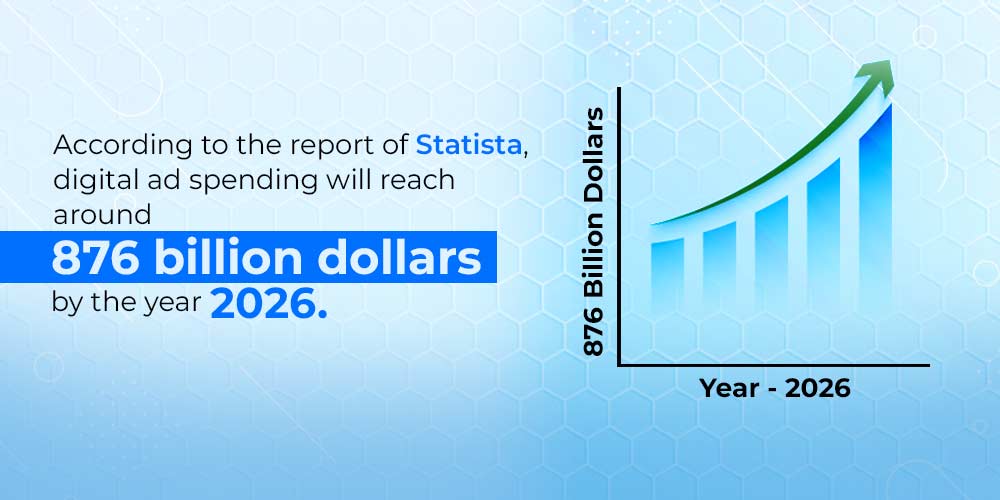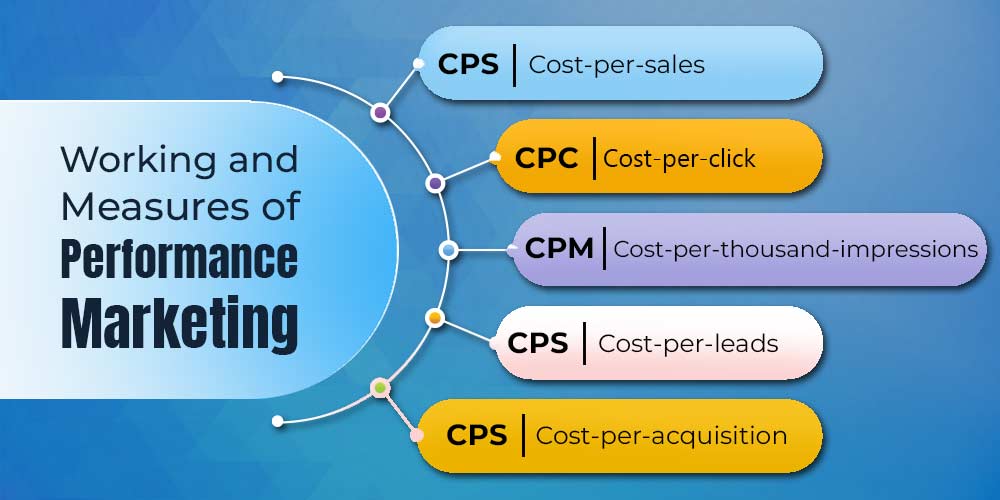Guide to Performance Marketing- 2024
Living in an era where you can get information and new skills on your finger count because of so much exposure and advancements in digital technology, the competition has also grown to heights. Businesses are now focused on results and revenues through expense over marketing. To pick the peculiar, you need to drive the performance of your business. So, here is the perfect guide to take you through Performance marketing in 2023!


Digital advertising had an expenditure of 521.02 billion U.S. dollars in 2021 globally. According to the report of Statista, this digital ad spending will reach around 876 billion dollars by the year 2026.
So, here also marks the big opportunity which you can make the most of if you can understand things initially which means making your marketing payable only when it performs.
So, this article is going to be interesting and we will be covering the following
What is performance marketing?
Benefits of Performance marketing.
Working and Measures of Performance Marketing
What is performance marketing?
Mixing up your paid advertisement strategy with branding goals is Performance Marketing. In this type of marketing, you pay advertisers or marketing companies only when your goal is met. So, this digital marketing strategy works directly based on desired results.
What can be your goals?
Goals are the result you want to achieve from any campaign. When it applies to digital paid advertisements, then you have goals like,
- Branding and enhanced visibility
- Getting up leads
- Generating sales
So, in performance marketing, you start your paid ad campaign and you are only charged when the goal you aligned is met. That’s perfect!
Types of performance marketing
Performance marketing encompasses a diverse array of strategies, each tailored to achieve specific objectives. Search Engine Marketing (SEM) involves paid search advertising on platforms like Google, targeting users actively searching for relevant keywords.
Social media advertising leverages platforms such as Facebook and Instagram to reach specific demographics and interests. Content marketing focuses on creating and distributing valuable content to attract and engage audiences. Email marketing nurtures leads and drives conversions through targeted email campaigns.
These are just a few examples of the versatile tactics within the performance marketing arsenal, each uniquely suited to meet distinct business goals.
Moving ahead, let’s look at the benefits that you can uphold using performance marketing.
Affiliate Marketing in Performance Marketing:
One facet of performance marketing that stands out is the dynamic realm of affiliate marketing. In this collaborative strategy, businesses partner with affiliates who promote their products or services. Affiliates, often bloggers or influencers, earn a commission for each sale, lead, or desired action generated through their promotional efforts. This performance-based model ensures that businesses only incur costs when the affiliate’s efforts yield tangible results. The symbiotic relationship between businesses and affiliates creates a win-win scenario, aligning incentives and fostering a results-driven approach.
Native Advertising in Performance Marketing:
Native advertising seamlessly integrates into the user experience, distinguishing itself from traditional display ads. In the realm of performance marketing, native ads harmoniously blend with organic content on websites and platforms. These ads mimic the format and style of the surrounding content, creating a non-disruptive and engaging user experience. Businesses utilizing native advertising in performance marketing can achieve a more natural and authentic connection with their audience, enhancing the likelihood of desired actions. This strategy exemplifies the adaptability and creativity embedded in performance marketing campaigns.
Benefits of performance marketing
The paid campaign which people generally use also has many benefits, but using performance marketing can add up to more of their interests in the following ways,
Proper control over expenditure
Adding up with performance marketing channels in your campaign provides you an extra edge with your financials. You hit your campaign directly and you are only being cost when your goal has been met. That means nothing to be paid extra for something that does not resolve your problem.
Once you have your revenue system in control and qualified expenditure, you can put emphasis on working and progressing your business.
This is why Performance campaigns in marketing are termed as cost-effective and result-orientated.
Traceable campaigns
Yes, the campaigns here are easily measurable. You don’t have any vague data. When you are already paid once your goal is achieved, then each time you get debited, your data adds up. In that way, you can very easily measure the activities of your campaigns and find out that is it performing well or not.
You can also find your return on investment with ease. You can make changes to your campaign as required and get back to business again, saving a lot of time and effort for you.
Targeting Pin Pointing Audience
It’s very simple. Your paid ad campaign is active and you have set the performance indicator as sales or lead, the same pattern will be what your ad is comprised of. Now, you only get paid when any of the visitors become your lead or generate sales over your platform.
Hence, you got the exact audience you were wishing for. The particular is your target audience. So, isn’t this amazing that you are only paid when you have your direct audience which can also be measured and traced easily at the same time?
That’s the point where I am like,
And, also why not?
This makes the business owners free from excessive workloads and focuses more and more on business niches, product/service lines, quality, and quantity. Apart from that, scaling and upgrading your enterprise!
Measurable Results in Performance Marketing:
At the core of performance marketing lies the commitment to measurable results. This fundamental characteristic sets it apart from traditional marketing approaches. Performance marketing campaigns are meticulously designed to produce quantifiable outcomes, whether it’s increased website traffic, lead generation, or sales. The use of key performance indicators (KPIs) allows businesses to track and analyze the effectiveness of their campaigns in real time. This data-driven approach not only provides valuable insights but also empowers businesses to make informed decisions and optimize their strategies for continuous improvement.
Working and Measures of Performance Marketing
By the time you have scrolled up the page here after giving it a read, one thing is sure this marketing technique is fabulous and gives access to explore more with fewer costs. Now, let us have a look at how it works or how can you measure it.
So, there come the following patterns to make the best use of performance marketing strategies as per your goals, they are
- CPC:: Cost-per-click
- CPM:: Cost-per-thousand-impressions
- CPS:: Cost-per-sales
- CPL:: Cost-per-leads
- CPA:: Cost-per-acquisition


CPC:-
as the name goes, Cost per Click, you are only charged if you want the visitor to click on your ad. Once the click is done, the goal will be achieved and you will be charged. Following the same, you can measure your campaign.
The goals you can use under CPC are
– Website Traffic
– Remarketing
– Engagement
CPM:-
Once your campaign is live under the CPC module, you get charged when your ad is visible at least 1000 times over GDN (Google Display Network). So based on your bidding, you have to pay the amount on every 1000 displays of your ads.
The goals you can use under CPM are
– Brand Awareness
– Website Traffic
CPS:-
You have your ad live under the goal which states that you only have to pay if you have achieved a sale for your business. In the same pattern, the ad is also prepared. For example, shopping ads are placed over the SERPs (Search Engine Ranking Pages)
CPL:-
If you want to generate leads for your business, you have a perfect way then. Start your campaigns Under the goal” Lead Generation” and you are cost whenever you can generate a lead for your business.
CPA:-
It is a combination of both CPL and CPS. Using CPA as a structure you can have various actionable paths you want from your visitor. For example,
– Making a sale
– Getting contact info
– Filling up a form
– Generating traffic to your sale page
– Visiting an informatory or general blog
This helps you achieve various specific actions using one structure rather than the ad placements on different metrics.


Performance Marketing Campaigns:
The heartbeat of performance marketing resides in its campaigns, where strategies are meticulously planned and executed to achieve tangible marketing objectives. Whether through SEM campaigns on search engines, social media ads, or content-driven initiatives, performance marketing campaigns are characterized by their data-driven nature. They involve setting clear campaign goals, identifying target audiences, allocating budgets effectively, and continuously monitoring and optimizing performance. The adaptability of performance marketing campaigns allows businesses to pivot in response to real-time data, ensuring agility in the pursuit of measurable success.
Landing Pages in Performance Marketing
Landing pages play a pivotal role in the success of performance marketing campaigns. These dedicated pages serve as digital storefronts, capturing visitors and guiding them towards specific actions, be it making a purchase or providing contact information. Effective landing pages incorporate key elements such as compelling headlines, benefit-driven content, strategic call-to-action (CTA) placement, and streamlined forms. Best practices involve aligning landing pages with campaign messaging, targeting specific audiences, and optimizing for search engines. The design principles of simplicity, clarity, and brand consistency ensure that landing pages contribute to the overall success of performance marketing initiatives.
Brand Marketing in Performance Marketing:
While performance marketing is inherently results-oriented, the integration of brand marketing enhances its impact. Brand marketing focuses on building awareness, reputation, and customer loyalty. When seamlessly integrated into performance marketing, a strong brand identity reinforces the effectiveness of campaigns. The recognition and trust established through brand marketing contribute to the success of performance-driven initiatives. The synergy between the two approaches ensures that measurable results align with positive brand perception, fostering sustainable growth and customer loyalty.
Marketing Tools in Performance Marketing:
The arsenal of tools available to practitioners of performance marketing plays a crucial role in optimizing campaigns and achieving measurable success. Analytics tools like Google Analytics and Adobe Analytics are instrumental in collecting and analyzing campaign data. These tools provide insights into user behavior, conversion rates, and other essential metrics. Additionally, marketing automation platforms streamline processes, enabling businesses to manage and optimize campaigns efficiently. The use of keyword research tools, A/B testing platforms, and attribution modeling tools further enhances the precision and effectiveness of performance marketing strategies.
Performance Marketing as a Digital Marketing Strategy:
Performance marketing stands at the forefront of digital marketing strategies, embodying a results-driven and data-centric approach. Unlike traditional marketing methods, performance marketing sets clear and achievable goals, aligning marketing efforts with overarching business objectives. This strategy utilizes various channels, including search engines, social media, content marketing, and email, to achieve specific and measurable outcomes. The benefits of performance marketing include cost-effectiveness, traceable campaigns, and the ability to precisely target desired audiences. As a dynamic digital marketing strategy, performance marketing empowers businesses to optimize their return on investment (ROI) and drive success in the competitive digital landscape.
Conclusion
Performance marketing can turn out to be a fantastic gem in your strategy with perfect cost-effectiveness and reaching the ultimate target you want. All that depends is following the right strategy and the right decisions.
You will need the right mentor who can make your path easy and smooth and help you in not making wrong decisions. As that dictates your marketing trajectory and course of action. So, you need to find one.
In case you want to connect with us, feel free to drop your comments down!
Till then, make your marketing work well!









